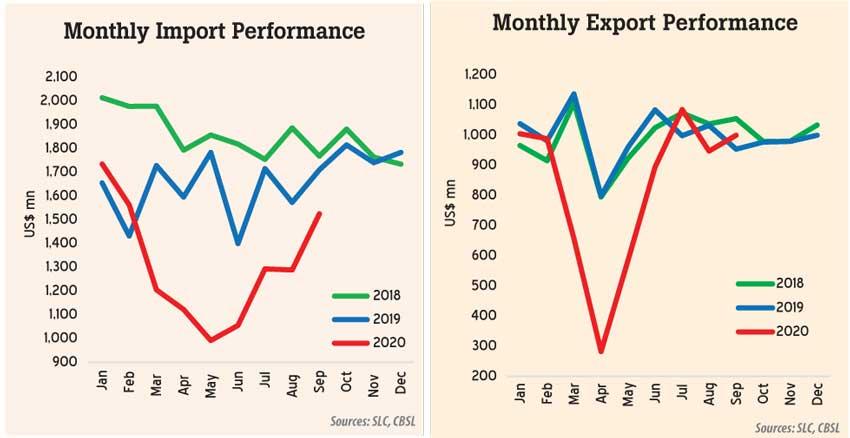10 Nov 2020 - {{hitsCtrl.values.hits}}

The trade deficit continued its descent in September from a year ago, amid the rise in export earnings while the temporary restrictions on non-essential imports and low oil prices kept a check on the import bill, assisting the external sector of the country.
The trade deficit narrowed to US $ 525 million in September, from US $ 757 million in the same month in 2019, bringing the cumulative deficit down to US $ 4.3 billion for the nine months, from US $ 5.6 billion recorded in the comparable period, last year.
September merchandise export earnings hit precisely a billion dollars, surpassing the US $ 947 million earned in August and US $ 954 million in the same month, last year.
The Central Bank joined the Export Development Board (EDB) in calling the merchandise export performance as a ‘V-shaped’ recovery.
“Exhibiting the resilience of the export sector in the midst of the current global market conditions and its V-shaped recovery since the initial outbreak of the COVID-19 pandemic, earnings from merchandise exports in September 2020 increased, both on a year-on-year basis as well as on a month-on-month basis,” the Central Bank said.
September marked the third month after January and July, where the exports recorded a billion dollars in earnings.
The preliminary data announced last week for October showed that the country had achieved over US $ 900 million in export earnings, a significant feat amid a second COVID-19 wave. The September exports were strengthened, particularly by the agricultural exports, led by coconuts, spices, tea and minor agricultural products, led by betel leaves and seafood. The total earnings from the agricultural exports increased by 10.4 percent to US $ 222.5 million, from the same period last year.
“Increased earnings from tea exports by 3.3 percent were supported by higher prices by 6.3 percent, as export volumes declined by 2.8 percent,” the Central Bank said.
Meanwhile, industrial exports were up by 3.6 percent to US $ 774.5 million, as personal protective equipment (PPE), made up of “plastic clothing, masks and gloves, which are categorised under plastics and articles thereof, other made up textile articles under textiles and garments and rubber products”, surpassed the decline in the garment exports, the Central Bank noted.
Textile and garment exports declined by 3.7 percent to US $ 434 million.
Food, beverage and tobacco exports—an industrial exports subcategory— also rose by a strong 36 percent, due to higher exports of value-added foods, led by value-added coconut products. Meanwhile, the imports declined by 10.9 percent in September to US $ 1.5 billion, assisted by the plunge in vehicle imports to almost zero levels and the lower crude oil prices. However, the September import bill was the highest since March and also marked an 18.3 percent increase over August, due to the increase in the importation of machinery and equipment.
The fuel bill for the month fell by 40 percent to US $ 214 million, with a cumulative nine-month decline of 35 percent to US $ 1.9 billion. The cumulative imports across all categories were US $ 11.8 billion, down 19.3 percent, from US $ 14.6 billion in the comparable period, last year.
However, the food and beverage subcategory, under consumer goods imports, surged by 35.9 percent to US $ 125.2 million, due to the increase in import of sugar, milk powder and coconut oil.
“Whereas the import prices of sugar were somewhat higher in September 2020, than in September 2019, the import prices of whole milk powder were lower in line with the prices in the global market,” the Central Bank said.
“Imports of non-food consumer goods that are not under import restrictions or are under less stringent restrictions, such as pharmaceuticals (mainly medicaments), telecommunication devices (mainly mobile phones), home appliances, such as refrigerators and rice cookers and toiletries, increased,” it added.
19 Nov 2024 39 minute ago
19 Nov 2024 2 hours ago
19 Nov 2024 2 hours ago
19 Nov 2024 2 hours ago
19 Nov 2024 2 hours ago